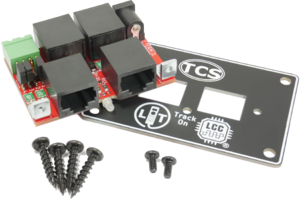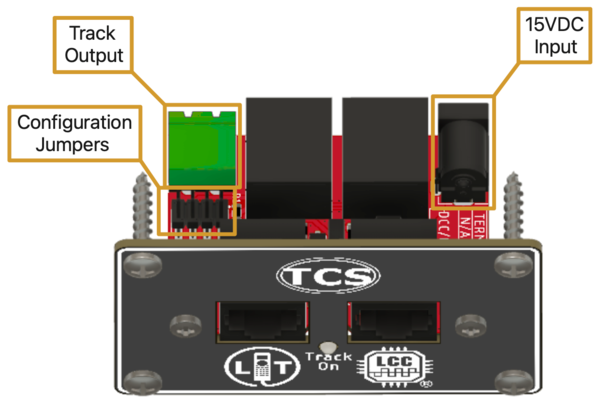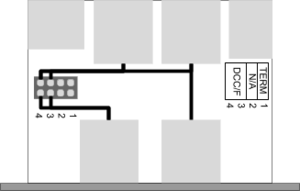Difference between revisions of "LT Panel"
| Line 52: | Line 52: | ||
|''Not Used'' | |''Not Used'' | ||
|- | |- | ||
| − | |DCC/F (3 | + | |{{Nowrap|DCC/F (3 4)}} |
|The LT Panel is designed to be use with a "Layout Throttle", such as an LT-50, plugged into the front facing port with the "LT" logo. [[File:DCC-F Simplified Diagram.png|thumb|300x300px|Simplified diagram showing the electrical connection for DCC/F jumpers.]]Insert these two jumpers to pass the low power DCC signals from the Layout Throttle through to the other three LCC jacks (pins 4 & 5 of the LCC-CAN standard). Remove these jumpers to disconnect the low power DCC signals provided by the Layout Throttle. | |The LT Panel is designed to be use with a "Layout Throttle", such as an LT-50, plugged into the front facing port with the "LT" logo. [[File:DCC-F Simplified Diagram.png|thumb|300x300px|Simplified diagram showing the electrical connection for DCC/F jumpers.]]Insert these two jumpers to pass the low power DCC signals from the Layout Throttle through to the other three LCC jacks (pins 4 & 5 of the LCC-CAN standard). Remove these jumpers to disconnect the low power DCC signals provided by the Layout Throttle. | ||
''Note: The Layout Throttle uses the [https://www.nmra.org/sites/default/files/standards/sandrp/pdf/s-9.1.2_power_station_interface.pdf NMRA S-9.1.2 Full Scale Interface]'' | ''Note: The Layout Throttle uses the [https://www.nmra.org/sites/default/files/standards/sandrp/pdf/s-9.1.2_power_station_interface.pdf NMRA S-9.1.2 Full Scale Interface]'' | ||
Revision as of 02:15, 6 October 2022
| LT Panel | |||||||||||||||
|---|---|---|---|---|---|---|---|---|---|---|---|---|---|---|---|
 | |||||||||||||||
| |||||||||||||||
The LT Panel is the same fascia panel assembly which comes included with the LT-50.
This product is an expansion panel for an LCC network, such as those created and used by the CS-105 and LT-50. Use this product to expand the number of wired throttles such as the T-50 you can connect to the TCS command station, or to provide an access point and/or power for other LCC devices distributed around your layout.
The LT Panel also includes a jack you can use to connect a Power Supply to power the LCC bus. (Not Included, except with LT-50)
Included In Package
- LT Panel board x1
- LT Panel fascia cover plate x1
- Fascia mounting screws x4
- Fascia cover plate screws x2
- Option Jumpers x3
Physical Overview
The LT Panel has a few notable physical features:
- Green 2-pin Track Output connector with detachable screw terminal connector
- 2.5mm x 5.5mm barrel jack for Power In
- Configuration Jumpers (see details below)
- Single "LT" RJ-45 jack(for LT-50 only)
- Three "LCC" RJ-45 jacks (1x Front: For T-50; 2x Rear for LCC Bus)
- Bi-color LED for "Track On"
Configuration Jumpers
Refer to the table below for information on the configuration jumpers available on the LT Panel:
| Jumper Position | Description |
|---|---|
| TERM (1) | Insert this jumper to add termination to the LCC-CAN bus. An LCC-CAN bus should have exactly two terminators, with one at each end of the bus.
This jumper can (optionally) provide for one of the required terminators. Note: In practicality, a very short (less than 10ft or 3m) LCC-CAN bus can still work reliably with one terminator. |
| N/A (2) | Not Used |
| Template:Nowrap | The LT Panel is designed to be use with a "Layout Throttle", such as an LT-50, plugged into the front facing port with the "LT" logo. Insert these two jumpers to pass the low power DCC signals from the Layout Throttle through to the other three LCC jacks (pins 4 & 5 of the LCC-CAN standard). Remove these jumpers to disconnect the low power DCC signals provided by the Layout Throttle.
Note: The Layout Throttle uses the NMRA S-9.1.2 Full Scale Interface
This circuit is only intended to be used to provide the signal from the LT-50 to other devices on the LCC-CAN bus. This circuit is not intended to supply signals to LCC boosters such as the B-106. This circuit must be disabled/open if another LCC device is driving the LCC-CAN pins 4 & 5 as allowed by the standard. The LT Panel is not designed to be used along with another LCC/DCC command station, such as the CS-105. In this case, an LCC Panel should be used instead. |

